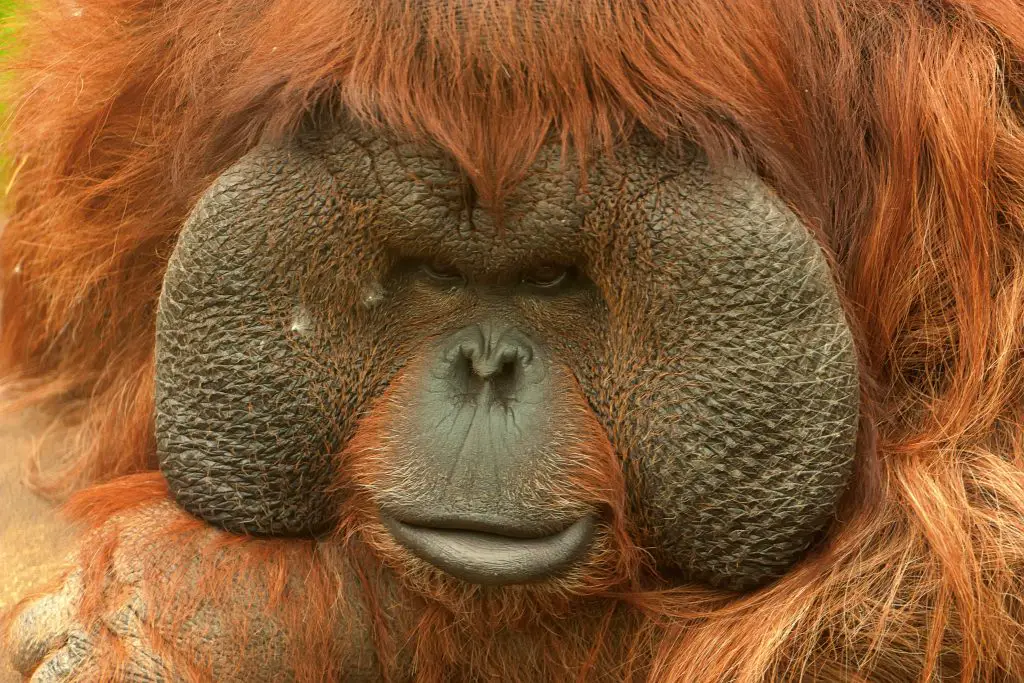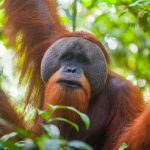Orangutans are a tribe of large apes that live in the rainforests of Indonesia and Malaysia. They had a wide range across China and South Asia until around 10,000 years ago.
They are now restricted to the islands of Sumatra and Borneo. As one might expect, their popular option has nothing to do with their orange coloration. Instead, it’s a Malay compound phrase that loosely translates to “forest person.”
The Sumatran orangutan the Bornean orangutan and the orangutan are three closely related species of orangutan. Because orangutan populations were split on different islands, environmental conditions caused minor changes in each species. Let’s look at what orangutans eat and how it relates to the diets of other big apes.

What Do Orangutans Eat?
Fruit accounts for over 90% of an orangutan’s diet. They consume about 400 different plant species. Durians are a favorite of orangutans. Durians have a strong odor and are coated in sharp spines. Orangutans cut into such fruits with a range of tools and their muscular jaws.
Although fruit makes up the majority of an orangutan’s diet, they still require extra nutrients regularly. Fruit provides a mix of sugars and lipids, while leaves provide carbohydrates and nuts provide protein. Orangutans consume or forage for food for up to six hours every day.
Orangutans are key propagators of tropical vegetation because they devour fruit. Many fruit seedlings only grow after passing through the digestive tract of an animal. As a result, orangutans play an important ecological role as seed decomposers in their rainforest habitat, influencing forest regeneration and plant variety.
The Orangutan Diet:
Fruit accounts for more than half of an orangutan’s diet; they prefer fleshy, soft fruits, especially those that grow in enormous quantities on their trees. Figs, drupes, and berries are also important parts of their diet, especially when their staple fruits are unavailable. They are the only documented animal that helps spread the somewhat toxic plant, and they operate as a seed diffuser for many of these fruit species.
Plant leaves are another important part of their diet; they are known to ingest over 400 different varieties of vegetation! They may rely more on leaves and bark when the fruit is scarce. They may spend a significant part of their day picking and eating leaves.
When orangutans come across bird eggs while moving through the woods, they are eager to eat them. They have been recorded eating tiny species like lizards, slow lemurs, and mice, albeit this is a rare occurrence. This is typically reserved for periods when the fruit is in short supply.
Orangutans usually spread out their foraging throughout the day. They may eat for 3 to 4 hours in the morning before having a nap in the afternoon. They will travel and hunt again after resting until it is time to bed down and build their nests. Each day, orangutans spend between 5 to 7 hours foraging and eating.
What Do Orangutans Drink?
Orangutans get the majority of their fluids from the juicy fruits they eat. They also capture moisture that accumulates on leaves and in tree crevices. When they need more water, they will come down from the trees and drink from rivers and streams. Orangutan babies will occasionally swallow water from their mother’s mouth.

Orangutan Feeding Methods:
Orangutans pull leaves from branches with their lips. To find fruiting trees, orangutans may memories the locations of transitory food sources, watch seasonal variations in fruiting peaks, and recognize behavioral indications from other animals.
Orangutans eat soil to assist absorb and neutralizing secondary plant metabolites (plant substances not directly involved in growth, development, or reproduction).
So most of the diet of orangutans consists of leaves and branches of the trees. They also love to eat fruits and vegetables from the trees. They are not many social animals and like to live alone in the forests.
Digestion is also another thing to consider. They like to choose those fruits that have fatty pulps in them because they are much easy to digest for them.







